
Wine Culture and Information since 2002 - Volume 22
 Wine Culture and Information since 2002 - Volume 22 |
|
Comparing Chianti ClassicoOne of the most representative wines of Tuscany and of Italian enology, Chianti Classico is one of the most famous reds in the world produced with Sangiovese grape |
|
One of the many wines who made Italy famous in the world certainly is Chianti, belonging to the glories of Tuscany. This renowned wine takes its name from the Colline del Chianti (Chianti Hills), a hilly area of about 20 kilometers in the territories of the provinces of Siena, Arezzo and Florence. In past times, the Chianti area was referred to the territories in the communes of Gaiole, Radda and Castellina only - all of them located in the province of Siena - which together formed the ancient Lega del Chianti (Chianti League) which then become the Province of Chianti. According to an enological point of view, these three areas represent today the so called Chianti Storico (Historical Chianti), however the area defined as “Chianti Classico” is today larger and includes other areas in the province of Florence and Siena. The bottles of wine belonging to Chianti Classico - an area of Denominazione d'Origine Controllata e Garantita (DOCG, Denomination of Controlled and Guaranteed Origin) - are always marked with the famous symbol of the black rooster, the emblem of the ancient Chianti League. The production area of Chianti's wines was one of the firsts to be regulated and defined by a law. On September 24th, 1717, grand duke Cosimo III de' Medici issued a special law in which were defined the borders of the Chianti, Pomino, Carmignano and Val d'Arno di Sopra regions, in which was allowed the production of the famous wine. The grand duke also issued a decree with which was established a special institution for the control of production, trading and frauds. The production area of Chianti - defined by the Italian quality system as DOCG - is today larger and includes a generic area simply defined as Chianti, the seven subareas of Colli Aretini, Colli Fiorentini, Colli Senesi, Colline Pisane, Montalbano, Montespertoli and Rufina, as well as the Chianti Classico area. Because of the many areas defined in the production disciplinary, Chianti is today subject of confusion among consumers. Many in fact define every wine from these areas with the generic Chianti name, whereas in other cases they use this name for the production from the classic area only.
|
|
In past times Chianti Classico was produced with Sangiovese grape only. In 1840 baron Bettino Ricasoli created a blend which he believed to be good for making a pleasing wine and to be drunk early, by adding Canaiolo Nero and Malvasia Bianca grapes. Moreover, barone Ricasoli introduced the so called method of the governo alla Toscana, consisting in adding, at the end of primary fermentation, the must of slightly dried grapes, in order to restart fermentation and to give wine a higher structure. Later was also decided to add Trebbiano Toscano to this blend, therefore defining the so called Chianti formula, very popular up to about twenty years ago. Nowadays Chianti producers are mainly focused on Sangiovese, most of the cases alone and most of the cases blended to the traditional Canaiolo Nero grape or other varieties, such as Merlot and Cabernet Sauvignon.
In our comparative tasting we will consider the evaluation of three wines produced with different grapes and aging periods. The first wine selected is Dievole's Chianti Classico Riserva Novecento, produced with Sangiovese, Canaiolo Nero, Colorino and Malvasia Nera grapes, aged for 18 months in barrique. The second wine is Castellare di Castellina's Chianti Classico Riserva Vigna il Poggiale, obtained from Sangiovese, Canaiolo Nero and Ciliegiolo grapes, also in this case aged for 18 months in barrique. The last wine of our comparative tasting is Castello di Fonterutoli's Chianti Classico Castello di Fonterutoli, produced with Sangiovese, Cabernet Sauvignon and Merlot grapes, aged in barrique for 16 months. The three Chianti Classico wines will be tasted at the temperature of 18° C (65° F) and served - as usual - in three ISO tasting glasses.
|
||||||||
|
Color and transparency in Chianti Classico strongly depends on the quality and type of grapes used for its production. Chianti Classico is mainly produced with Sangiovese, a grape with a moderate content in polyphenols and which usually makes wines with a moderate transparency. Sangiovese makes wines with low transparency in case of low yield harvests, followed by proper wine making procedures, an essential condition for quality wines. Also color is affected by this factor and, in case of Chianti Classico, also by the coloring properties of the other grapes used in the production. In its first years of life, Chianti Classico is characterized by an intense and brilliant ruby red color, with a moderate transparency, in some cases being pretty low as well. As years pass by, colors in Chianti Classico follow the natural evolution which can be observed in other red wines, passing from ruby red to garnet red, then becoming, at the top of its evolution, brick red. Let's begin appearance analysis of our wines from Dievole's Chianti Classico Riserva Novecento. By holding the glass tilted over a white surface - a sheet of paper will be enough - let's observe the color of the wine at the base of the glass: it will be noticed a dark and deep ruby red color, with a pretty low transparency. Let's now observe the edge of the liquid mass, towards the opening of the glass, in order to appreciate nuances. It will be observed a garnet red color, a sign of the development of wine aging. Let's now pass to the observation of the second wine of our comparative tasting: Castellare di Castellina's Chianti Classico Riserva Vigna il Poggiale. The color of this second Chianti Classico is intense ruby red, also in this case, with a pretty low transparency. Also in the nuance will be observed a ruby red color. The color of the third wine - Castello di Fonterutoli's Chianti Classico Castello di Fonterutoli - is characterized by an intense ruby red, with a pretty low transparency, whereas in the nuance will be observed a garnet red color.
|
|
The aromatic profile of Chianti Classico is strongly characterized by the aromatic qualities of its main protagonist: Sangiovese. Despite in Chianti Classico are frequently used other grapes - such as the traditional Canaiolo Nero as well as the more recent Cabernet Sauvignon and Merlot - will be the qualities of Sangiovese to be noticed from the glass, to which will follow the qualities of other grapes and the complex aromas given by the aging in wood and time. The world of aromas of Chianti Classico is mainly characterized by red and black berried fruits as well as by flowers. Among the most common aromas which can be found in Chianti are mentioned black cherry, plum, blueberry and blackberry, whereas in flower aromas, violet is the one to play the main role. Thanks to the aging in wood, in Chianti Classico will also be perceived spicy aromas such as vanilla, licorice, cinnamon, nutmeg and black pepper, as well as balsamic hints of menthol and eucalyptus. Among other typical aromas in Chianti Classico are mentioned tobacco, leather, cocoa and chocolate. The evaluation of aromas of our comparative tasting will begin from Dievole's Chianti Classico Riserva Novecento. By holding the glass in vertical position and without swirling, we will do a first smell in order to perceive opening aromas, that is the ones made of light molecules and requiring a small quantity of oxygen to volatilize. From the glass will emerge clean and intense aromas of black cherry, plum and violet, three typical and identifying qualities of Sangiovese grape. Let's now proceed by swirling the glass in order to favor the oxygenation and volatilization of other aromatic substances, therefore completing the olfactory profile of this first Chianti Classico. By tilting the glass and by doing a second smell, we will perceive aromas of blueberry, vanilla, tobacco, cinnamon, cocoa, licorice and eucalyptus, to which will follow pleasing hints of lavender and black pepper. Let's now pass to the aromas evaluation of the second wine of our comparative tasting: Castellare di Castellina's Chianti Classico Riserva Vigna il Poggiale. The opening of this Chianti Classico reserve is characterized by black cherry, plum and violet, also in this case very typical in Sangiovese grape. After having swirled the glass, we will do a second smell which will complete the olfactory profile of the wine with aromas of blueberry, raspberry, licorice, vanilla, chocolate, tobacco and menthol with hints of leather. Also the opening of the third wine of our comparative tasting - Castello di Fonterutoli's Chianti Classico Castello di Fonterutoli - is characterized by aromas of black cherry, plum, blackberry and violet, therefore confirming the dominant presence of Sangiovese. The second smell, done after having swirled the glass, will allow the perception of the aromas of black currant, blueberry, vanilla, cyclamen, tobacco, licorice, cocoa and eucalyptus, as well as hints of cinchona and leather.
|
||||
|
The tasting of Chianti Classico is characterized, just like the olfactory evaluation, by the organoleptic qualities of Sangiovese which, according to production disciplinary, must represent at least 80% of the grapes used for the production of this wine. Sangiovese is a grape with an average content of polyphenolic substances and an appreciable acidity. The aging in wood will allow wines produced with Sangiovese to smooth crispness, while contributing to increase structure. The “harshness” of Sangiovese in Chianti Classico is also mitigated by Canaiolo Nero, as well as by Merlot, a presence which is becoming more and more frequent in this famous wine. Crispness and astringency of Chianti Classico require a proper quantity of alcohol in order to reach balance, which in this case is generally equal to 13.5%. The first wine we will taste is Dievole's Chianti Classico Riserva Novecento. The attack of this wine is characterized by an appreciable astringency, well balanced by roundness and alcohol, completed by the pleasing crispness of Sangiovese and a definitely robust body. It should be noticed the excellent correspondence to the nose, in particular the flavors of black cherry and plum. Let's now pass to the evaluation of the second wine of our comparative tasting: Castellare di Castellina's Chianti Classico Riserva Vigna il Poggiale. Also in this wine the attack is tannic with a pleasing roundness which mitigates astringency, balanced by the presence of alcohol and a full body. The attack of the third wine, Castello di Fonterutoli's Chianti Classico Castello di Fonterutoli, is characterized by an attack of robust structure and for its evident astringency, however well balanced both by roundness and by alcohol, to which is added the pleasing crispness of Sangiovese.
|
|
The final phase of our comparative tasting will focus on the sensations left on the mouth after the wines have been swallowed. The finish of Dievole's Chianti Classico Riserva Novecento is persistent with intense, clean and pleasing flavors of black cherry, plum and blueberry, typical qualities in many grapes and, in particular, in Sangiovese. Also the finish of Castellare di Castellina's Chianti Classico Riserva Vigna il Poggiale is persistent, leaving in the mouth intense, pleasing and clean flavors of black cherry, plum and blueberry, just like the previous wine. The finish of the third wine of our comparative tasting, Castello di Fonterutoli's Chianti Classico Castello di Fonterutoli, is very persistent, leaving in the mouth long and intense flavors of black cherry, blackberry and blueberry. It should be noticed the perception of the structure and crispness also after having swallowed the wine, as well as the excellent correspondence to the nose of all the three Chianti Classico.
|
Wines of the Month |
|
|
|
Score legend Prices are to be considered as indicative. Prices may vary according to the country or the shop where wines are bought |
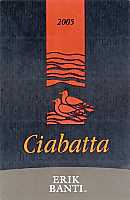
|
|
Morellino di Scansano Riserva Ciabatta 2005 |
|
| Erik Banti (Tuscany, Italy) | |
| Grapes: Sangiovese | |
| Price: € 12.00 | Score: |
| Morellino di Scansano Riserva Ciabatta shows an intense ruby red color and nuances of ruby red, little transparency. The nose reveals intense, clean, pleasing and refined aromas that start with hints of black cherry, plum and violet followed by aromas of blueberry, blackberry, vanilla, pink pepper, carob and tobacco. The mouth has good correspondence to the nose, a tannic attack and however balanced by alcohol, good body, intense flavors. The finish is persistent with flavors of black cherry, plum and blackberry. Morellino di Scansano Riserva Ciabatta ages in cask for 13 months. | |
| Food Match: Broiled meat and barbecue, Roasted meat, Stewed meat with mushrooms | |
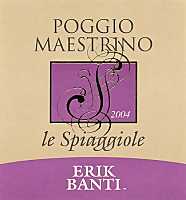
|
|
Poggio Maestrino Le Spiaggiole 2004 |
|
| Erik Banti (Tuscany, Italy) | |
| Grapes: Merlot (40%), Cabernet Sauvignon (30%), Syrah (30%) | |
| Price: € 10.00 | Score: |
| Poggio Maestrino Le Spiaggiole shows an intense ruby red color and nuances of garnet red, little transparency. The nose reveals intense, clean, pleasing, refined and elegant aromas that start with hints of black cherry, plum and black currant followed by aromas of blueberry, violet, vanilla, geranium, tobacco, pink pepper, caper, cocoa and menthol. The mouth has good correspondence to the nose, a tannic attack and however balanced by alcohol, full body, intense flavors, agreeable roundness. The finish is persistent with flavors of black cherry, plum and black currant. A well made wine. Poggio Maestrino Le Spiaggiole ages for 14 months in cask. | |
| Food Match: Game, Roasted meat, Stewed and braised meat, Hard cheese | |
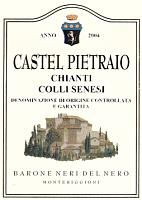
|
|
Chianti Colli Senesi Castel Pietraio 2004 |
|
| Fattoria di Castel Pietraio (Tuscany, Italy) | |
| Grapes: Sangiovese (95%), Canaiolo Nero (5%) | |
| Price: € 5.50 | Score: |
| This wine shows a brilliant ruby red color and nuances of garnet red, moderate transparency. The nose denotes intense, clean and pleasing aromas that start with hints of black cherry, plum and blackberry followed by aromas of violet, raspberry and blueberry. The mouth has good correspondence to the nose, a slightly tannic and crisp attack, however balanced by alcohol, good body, intense flavors. The finish is pretty persistent with flavors of plum and black cherry. | |
| Food Match: Broiled meat and barbecue, Sauteed meat, Stuffed pasta | |
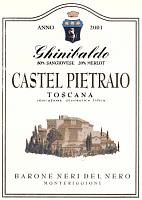
|
|
Ghinibaldo 2001 |
|
| Fattoria di Castel Pietraio (Tuscany, Italy) | |
| Grapes: Sangiovese (80%), Merlot (20%) | |
| Price: € 18.00 | Score: |
| Ghinibaldo shows a deep ruby red color and nuances of ruby red, little transparency. The nose reveals intense, clean, pleasing, refined and elegant aromas that start with hints of black cherry, plum and black currant followed by aromas of violet, blueberry, vanilla, tobacco, licorice, eucalyptus, chocolate, clover and mace. The mouth has good correspondence to the nose, a tannic attack and however balanced by alcohol, full body, intense flavors, agreeable. The finish is persistent with flavors of black cherry, plum and black currant. A well made wine. Ghinibaldo ages for 14 months in barrique followed by at least 12 months of aging in bottle. | |
| Food Match: Game, Roasted meat, Stewed and braised meat, Hard cheese | |
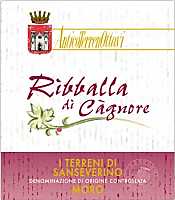
|
|
I Terreni di Sanseverino Moro Ribballa di Cagnore 2004 |
|
| Antico Terreno Ottavi (Marches, Italy) | |
| Grapes: Montepulciano | |
| Price: € 12.00 | Score: |
| This wine shows an intense ruby red color and nuances of ruby red, little transparency. The nose reveals intense, clean, pleasing and refined aromas that start with hints of black cherry, plum and violet followed by aromas of blueberry, black currant, vanilla, tobacco, chocolate, mace and menthol. The mouth has good correspondence to the nose, a tannic attack and however balanced by alcohol, good body, intense flavors. The finish is persistent with flavors of black cherry, plum and blueberry. This wine ages for 16-18 months in barrique. | |
| Food Match: Roasted meat, Braised and stewed meat, Broiled meat and barbecue | |
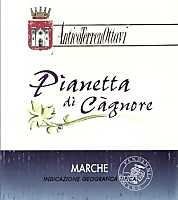
|
|
Pianetta di Cagnore Le Goduriose 2003 |
|
| Antico Terreno Ottavi (Marches, Italy) | |
| Grapes: Vernaccia Nera, Montepulciano, Sangiovese | |
| Price: € 15.00 | Score: |
| Pianetta di Cagnore Le Goduriose shows an intense ruby red color and nuances of ruby red, little transparency. The nose reveals intense, clean, pleasing and refined aromas that start with hints of black cherry, plum and blackberry followed by aromas of blueberry, violet, vanilla, black pepper, tobacco, chocolate and menthol. The mouth has good correspondence to the nose, a tannic attack and however balanced by alcohol, good body, intense flavors. The finish is persistent with flavors of black cherry, plum and blackberry. Pianetta di Cagnore Le Goduriose ages for 18 months in barrique. | |
| Food Match: Roasted meat, Stewed and braised meat with mushrooms, Hard cheese | |
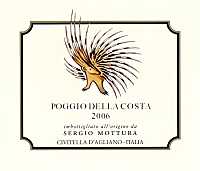
|
|
Poggio della Costa 2006 |
|
| Sergio Mottura (Latium, Italy) | |
| Grapes: Grechetto | |
| Price: € 9.90 | Score: |
| Poggio della Costa shows a brilliant greenish yellow color and nuances of greenish yellow, very transparent. The nose reveals intense, clean, pleasing and refined aromas that start with hints of pear, peach and pineapple followed by aromas of hawthorn, apple, hazelnut and broom. The mouth has good correspondence to the nose, a crisp attack and however balanced by alcohol, good body, intense flavors. The finish is persistent with flavors of pear, peach and pineapple. Poggio della Costa ages for 6 months in steel tanks followed by 2 months of aging in bottle. | |
| Food Match: Pasta and risotto with vegetables and fish, Sauteed fish, Legumes soups | |
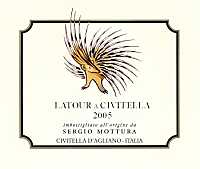
|
|
Latour a Civitella 2005 |
|
| Sergio Mottura (Latium, Italy) | |
| Grapes: Grechetto | |
| Price: € 15.90 | Score: |
| Latour a Civitella shows a brilliant straw yellow color and nuances of straw yellow, very transparent. The nose reveals intense, clean, pleasing and refined aromas which start with hints of apple, pear and plum followed by aromas of pineapple, citrus fruits, vanilla, hazelnut, hawthorn, grapefruit and butter. The mouth has good correspondence to the nose, a crisp attack and however balanced by alcohol, good body, intense flavors, agreeable. The finish is persistent with flavors of plum, apple and hazelnut. Latour a Civitella ages for 9 months in cask followed by 6 months of aging in bottle. | |
| Food Match: Pasta with meat, roasted fish, Roasted white meat, Mushroom soups | |
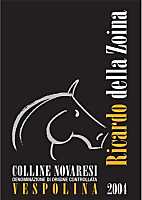
|
|
Colline Novaresi Vespolina Ricardo della Zoina 2004 |
|
| Cascina Zoina (Piedmont, Italy) | |
| Grapes: Vespolina | |
| Price: € 8.00 | Score: |
| This wine shows a brilliant ruby red color and nuances of ruby red, moderate transparency. The nose denotes intense, clean, pleasing and refined aromas that start with hints of cherry and plum followed by aromas of rose, violet, vanilla, chocolate, tobacco and menthol. The mouth has good correspondence to the nose, a slightly tannic attack and however balanced by alcohol, good body, intense flavors. The finish is persistent with flavors of cherry and plum. Colline Novaresi Vespolina Ricardo della Zoina ages for 12 months in barrique. | |
| Food Match: Stuffed pasta, Stewed meat with mushrooms, Broiled meat and barbecue | |
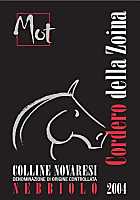
|
|
Colline Novaresi Nebbiolo Cordero della Zoina Mot 2004 |
|
| Cascina Zoina (Piedmont, Italy) | |
| Grapes: Nebbiolo | |
| Price: € 11.00 | Score: |
| The wine shows a brilliant ruby red color and nuances of brick red, moderate transparency. The nose denotes intense, clean, pleasing and refined aromas that start with hints of black cherry, plum and strawberry followed by aromas of violet, vanilla, tobacco, cocoa and tar. The mouth has good correspondence to the nose, a tannic attack and pleasing crispness, however balanced by alcohol, good body, intense flavors. The finish is persistent with flavors of black cherry, strawberry and plum. This wine ages for 24 months in barrique followed by 5 months in steel tanks and at least 12 months in bottle. | |
| Food Match: Roasted meat, Braised and stewed meat, Hard cheese | |
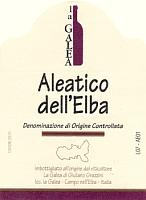
|
|
Aleatico dell'Elba 2005 |
|
| La Galea (Tuscany, Italy) | |
| Grapes: Aleatico | |
| Price: € 24.00 - 50cl | Score: |
| The wine shows a brilliant ruby red color and nuances of garnet red, moderate transparency. The nose denotes intense, clean, pleasing and refined aromas that start with hints of blackberry, black cherry and geranium followed by aromas of raspberry, strawberry, blueberry, violet, plum and pink pepper. The mouth has good correspondence to the nose, a sweet and slightly tannic attack, however balanced by alcohol, good body, intense flavors, pleasing roundness and crispness. The finish is persistent with flavors of blackberry, black cherry and strawberry. This Aleatico dell'Elba ages for 12 months in steel tanks. | |
| Food Match: Fruit desserts, Jam tarts | |

|
|
Sagrantino di Montefalco 2004 |
|
| Terre de La Custodia (Umbria, Italy) | |
| Grapes: Sagrantino | |
| Price: € 21.70 | Score: |
| This Sagrantino di Montefalco shows an intense ruby red color and nuances of ruby red, little transparency. The nose reveals intense, clean, pleasing and refined aromas that start with hints of black cherry, blackberry and plum followed by aromas of violet, blueberry, vanilla, tobacco, cocoa and menthol. The mouth has good correspondence to the nose, a tannic attack and however balanced by alcohol, full body, intense flavors. The finish is persistent with flavors of black cherry, blackberry and plum. This Sagrantino di Montefalco ages for 15 months in barrique followed by 8 months of aging in bottle. | |
| Food Match: Game, Stewed and braised meat, Roasted meat, Hard cheese | |

|
|
Sagrantino di Montefalco Passito Melanto 2004 |
|
| Terre de La Custodia (Umbria, Italy) | |
| Grapes: Sagrantino | |
| Price: € 23.20 - 375ml | Score: |
| Sagrantino di Montefalco Passito Melanto shows a deep ruby red color and nuances of ruby red, little transparency. The nose reveals intense, clean, pleasing and refined aromas that start with hints of blackberry, black cherry and plum followed by aromas of violet, vanilla, tobacco, cinnamon, carob, caramel and pink pepper. The mouth has good correspondence to the nose, a tannic and sweet attack, however balanced by alcohol, full body, intense flavors, agreeable. The finish is persistent with flavors of blackberry, black cherry and plum. Sagrantino di Montefalco Passito Melanto ages for 12 months in barrique followed by 12 months of aging in bottle. | |
| Food Match: Fruit and jam tarts, Hard cheese | |
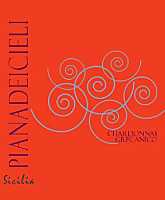
|
|
Chardonnay Grecanico 2006 |
|
| Pianadeicieli (Sicily, Italy) | |
| Grapes: Chardonnay (60%), Grecanico (40%) | |
| Price: € 9.40 | Score: |
| This wine shows an intense golden yellow color and nuances of golden yellow, very transparent. The nose reveals intense, clean, pleasing and refined aromas that start with hints of apple, lychee and banana followed by aromas of acacia, medlar, peach, pear, pink grapefruit, plum, honey and mineral. The mouth has good correspondence to the nose, a crisp attack and however balanced by alcohol, good body, intense flavors, pleasing roundness. The finish is persistent with flavors of lychee, apple and plum. This wine ages in steel tanks. | |
| Food Match: Stuffed pasta, Pasta with mushrooms and crustaceans, Sauteed fish, Vegetable and mushroom soups | |
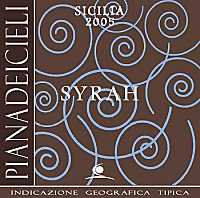
|
|
Syrah 2005 |
|
| Pianadeicieli (Sicily, Italy) | |
| Grapes: Syrah | |
| Price: € 10.00 | Score: |
| This Syrah shows an intense ruby red color and nuances of ruby red, little transparency. The nose denotes intense, clean, pleasing, refined and elegant aromas which start with hints of black currant, black cherry and plum followed by aromas of violet, blueberry, black pepper, vanilla, blackberry, carob, lavender and mace. The mouth has good correspondence to the nose, a tannic attack and however balanced by alcohol, good body, intense flavors, agreeable. The finish is persistent with flavors of black currant, black cherry and plum. A well made wine. This Syrah ages for 8 months in barrique. | |
| Food Match: Roasted meat, Stewed and braised meat, Hard cheese | |
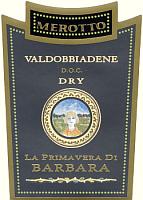
|
|
Prosecco di Valdobbiadene Dry La Primavera di Barbara 2006 |
|
| Merotto (Veneto, Italy) | |
| Grapes: Prosecco (90%), Perera (10%) | |
| Price: € 11.75 | Score: |
| Prosecco di Valdobbiadene Dry La Primavera di Barbara shows a brilliant greenish yellow color and nuances of greenish yellow, very transparent, fine and persistent perlage. The nose reveals intense, clean, pleasing and refined aromas that start with hints of pear, apple and pineapple followed by aromas of peach, wistaria, citrus fruits, hawthorn, broom, plum and sage. The mouth has good correspondence to the nose, an effervescent and crisp attack, pleasing sweetness, however balanced by alcohol, good body, intense flavors. The finish is persistent with flavors of pear, pineapple and peach. Prosecco di Valdobbiadene Dry La Primavera di Barbara ferments for about 50 days in tanks. | |
| Food Match: Risotto with crustaceans, Broiled crustaceans, Vegetable flans | |
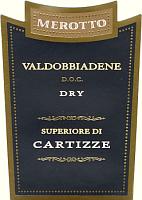
|
|
Prosecco di Valdobbiadene Dry Superiore di Cartizze |
|
| Merotto (Veneto, Italy) | |
| Grapes: Prosecco | |
| Price: € 23.00 | Score: |
| This Prosecco shows a brilliant greenish yellow color and nuances of greenish yellow, very transparent, fine and persistent perlage. The nose reveals intense, clean, pleasing and refined aromas that start with hints of pear, pineapple and apple followed by aromas of peach, wistaria, white rose, plum, broom and hawthorn. The mouth has good correspondence to the nose, an effervescent and crisp attack, pleasing sweetness, however balanced by alcohol, good body, intense flavors. The finish is persistent with flavors of pear, peach and pineapple. Prosecco di Valdobbiadene Dry Superiore di Cartizze ferments in tank for about 50 days. | |
| Food Match: Boiled fish, Vegetable flans, Risotto with crustaceans | |
|
||||||||
|
DiWineTaste Polls
|
| |||||||
Privacy Policy | |||||||


| Copyright © 2002-2024 Antonello Biancalana, DiWineTaste - All rights reserved |
| All rights reserved under international copyright conventions. No part of this publication and of this WEB site may be
reproduced or utilized in any form or by any means, electronic or mechanical, without permission in writing from DiWineTaste. |